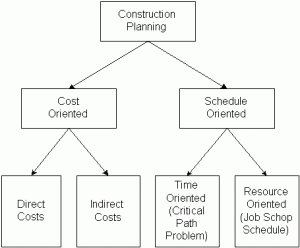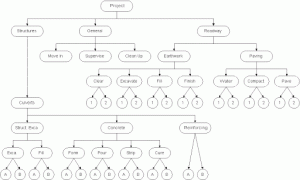Construction Planning
Purpose : To define and refine objectives, and to establish a plan of action required to attain the objectives and scope of the project
Refine scope
Define approach
Identify major tasks and deliverables
Define milestones
Develop Work Breakdown Structure
Develop schedule
Define specific skills and resource requirements
Plan review points
Develop plans for managing project
In developing a construction plan, it is common to adopt a primary emphasis on either cost control or on schedule control
Defining Precedence Relationships Among Activities

In forming a construction plan, a useful approach is to simulate the construction process either in the imagination of the planner or with a formal computer based simulation technique. By observing the result, comparisons among different plans or problems with the existing plan can be identified. For example, a decision to use a particular piece of equipment for an operation immediately leads to the question of whether or not there is sufficient access space for the equipment. Three dimensional geometric models in a computer aided design (CAD) system may be helpful in simulating space requirements for operations and for identifying any interferences. Similarly, problems in resource availability identified during the simulation of the construction process might be effectively forestalled by providing additional resources as part of the construction plan.
Defining Work Tasks
Defining Precedence Relationships Among Activities
Estimating Activity Durations All formal scheduling procedures rely upon estimates of the durations of the various project activities as well as the definitions of the predecessor relationships among tasks. The variability of an activity’s duration may also be considered.
Estimating Resource Requirements for Work Activities
The initial problem in estimating resource requirements is to decide the extent and number of resources that might be defined. At a very aggregate level, resources categories might be limited to the amount of labor (measured in man-hours or in dollars), the amount of materials required for an activity, and the total cost of the activity. At this aggregate level, the resource estimates may be useful for purposes of project monitoring and cash flow planning. For example, actual expenditures on an activity can be compared with the estimated required resources to reveal any problems that are being encountered during the course of a project
More detailed definitions of required resources would include the number and type of both workers and equipment required by an activity as well as the amount and types of materials. Standard resource requirements for particular activities can be recorded and adjusted for the special conditions of particular projects. As a result, the resources types required for particular activities may already be defined. Reliance on historical or standard activity definitions of this type requires a standard coding system for activities.







